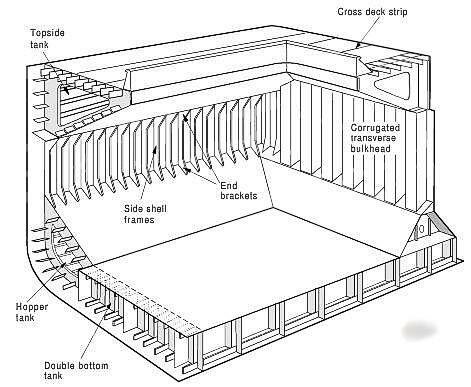

Home ||| Bulk Cargo ||| Planning ||| Care ||| Safety||| Self unloaders
(DB) tanks,topside tanks & wing tanks for bulk carriers ballast handling

All bulk carriers must have ballast tanks of sufficient capacity to allow immersion of the propeller and ensure suitable trim and stability. The ballast conditions of a bulk carrier are as follows:
- Light ballast has empty ballast holds
- heavy ballast (seagoing condition), which is with the ballast holds full
- port condition is for trimming/air draught situations, using the additional dedicated cargo ballast holds that are for port use only.
Topside Tanks
These are tanks of triangular configuration fitted at both shoulders/wings of the cargo holds. Their purpose is to carry ballast water. Topside tanks consist of a `transverse ring' made from frames in the transverse direction. Each transverse ring consists of:
- A deck transverse the part of the frame under the deck supporting the deck plating
- a side transverse the part of the frame supporting the side shell plating. This is in line with the side shell frames within the cargo holds (in single skin bulk carriers)
- a bottom transverse the part of the frame supporting the bottom part of the topside tank.
The topside tanks are connected to the main ballast system of the ship. When discharging topside tanks the BLU Code stipulates that during the loading/ discharging of cargo the discharge rate must remain constant and that the weight of ballast water should be harmonized with the weight of the cargo.
Wing Tanks (Lower Hopper Tanks)
These tanks are on the sides of the vessel within the bottom wing of each cargo hold and are the continuation of the DB tanks. They provide additional space for ballast and the sloping margins of the tanktop to collect the cargo in the central part of the hold.
The fuel tank plating forms a sloping boundary that carries static and dynamic load due to cargo and ballast. The transverse frames in the wing tanks are divided into three types, side transverse, bottom transverse and bilge transverse, according to the structure to which they are attached.
In addition to carrying ballast, the upper and lower wing tanks have the following advantages:
- The space where an untrimmed cargo would otherwise shift into is occupied by the upper wing tanks and void space (upper stool), meaning cargoes such as grain can sometimes be carried without being trimmed.
- the lower wing tank, combined with the lower void space, shapes the lower part of the cargo hold enabling cargo to be easily accessed in the central part of the hold when discharged with grabs.

Fig : Tanks configuration of a typical bulk carrier
Double Bottom (DB) Tanks
The double bottom is fitted between the forward collision bulkhead and the after peak bulkhead. Its top or `inner bottom' forms the deck of the cargo holds and continues out to the ship's side so that the turn of the bilge can be protected.
The design of double bottom tanks is based on the length of the ship, ie for ships longer than 120 m the arrangement of DB tanks and sloped bulkheads of wing tanks consists of longitudinal framing, while for ships of 120 m or less the arrangement consists of transverse framing (at least) within the cargo hold. The cargo hold area directly below the hatchway must be strengthened. On many ships, the double bottom is divided transversely into three compartments instead of two. In this case, there is a central void known as the `duct keel' where piping may be routed.
As noted earlier, wing tanks and DBs are connected and form part of the ballast system with the exception that some DBs are dedicated FO/DO tanks only and will not be connected to the ballast system, avoiding any chance of contamination.
Lower hopper and DB tanks in the aft hold can be fuel tanks while, correspondingly, top side tanks are ballast.
Top articles
- Hatch cover strength requirement for a seagoing bulk carrier
- Countermeasures against ships structural damage
- Ships longitudinal subdivisions - use of transverse watertight bulkheads
- Indication of unusual motion or attitude of bulk carriers and risk management / evacuation
- Deterioration of ships structure and consequences of forward flooding
- Handling water ingress problems in bulk carrier, investigation and countermeasures
- Survival and safety procedure for bulk carriers
- Suitability of Shore Terminals for handling bulk cargo
- Preparation for ships carrying bulk cargo & standard loading condition
Related info:
Structural strength requirements for mechanical steel hatch covers
Ships structural problem because of corrosion & metal fatigues - related countermeasures
Classification Society Establishes Design Standards For Bulk Carriers
Our detail pages illustrated many safety aspects of Bulk carrier
Home page |||Bulk carrier types ||| Handling of bulk coal |||Cargo planning ||| Carriage of grain |||Risk of iron ores |||Self unloading bulk carriers |||Care of cargo & vessel |||Cargoes that may liquefy |||Suitability of ships |||Terminal guideline |||Hold cleaning |||Cargo cranes |||Ballast handling procedure |||Bulk carrier safety |||Fire fighting systems |||Bulk carrier General arrangement

Operation of sea going bulk carriers involved numerous hazards . Careful planning and exercising due caution for all critical shipboard matters are important . This site is a quick reference to international shipping community with guidance and information on the loading and discharging of modern bulk carriers so as to remain within the limitations as specified by the classification society.
It is vital to reduce the likelihood of over-stressing the ship's structure and also complying with all essential safety measures for a safe passage at sea. Our detail pages contain various bulk carrier related topics that might be useful for people working on board and those who working ashore in the terminal. For any remarks please Contact us
Copyright © 2010 bulkcarrierguide.com All rights reserved.
Although every effort have been taken to improve the accuracy of content provided the publisher of this website cannot gaurantee for errors. Disclaimer Privacy policy Home page
